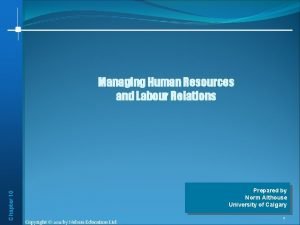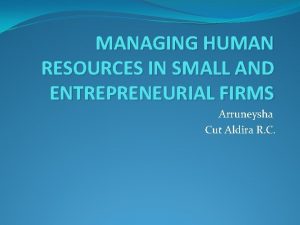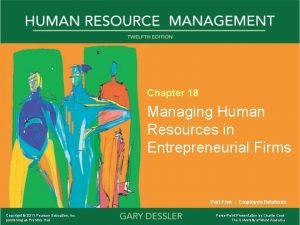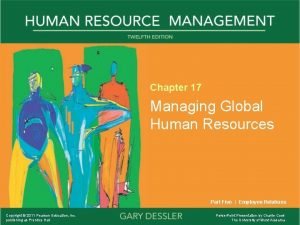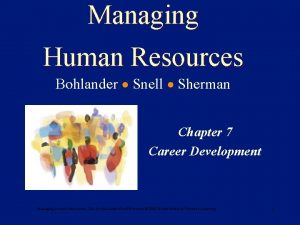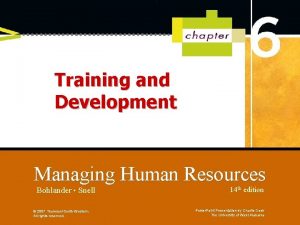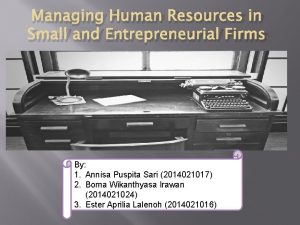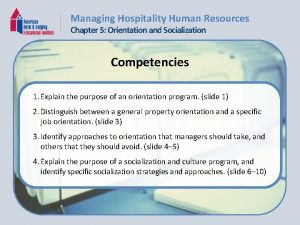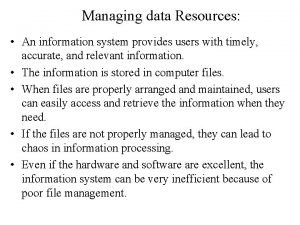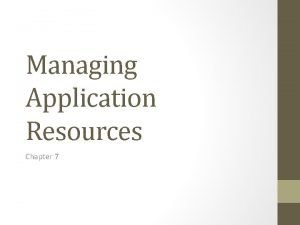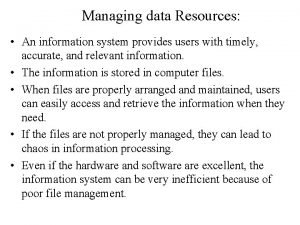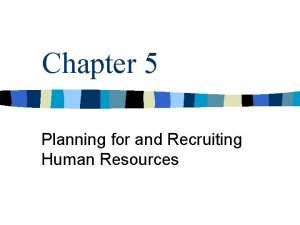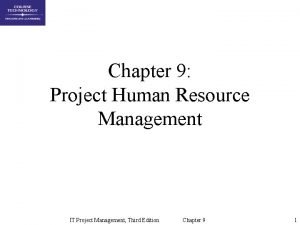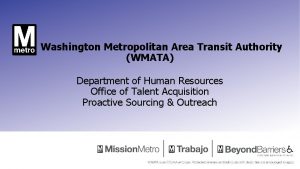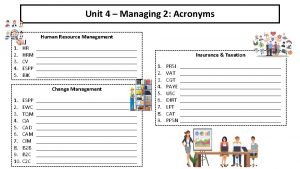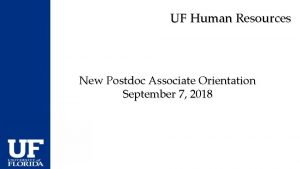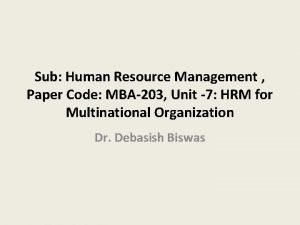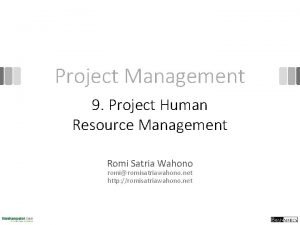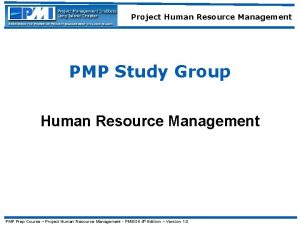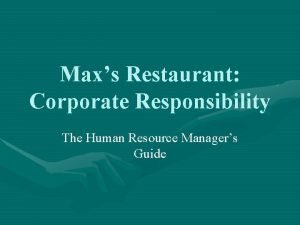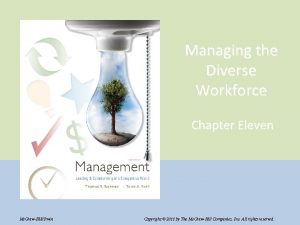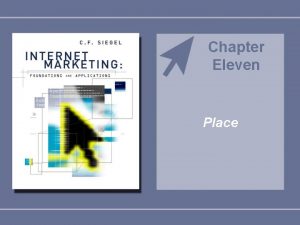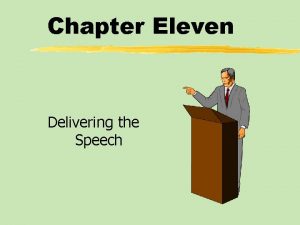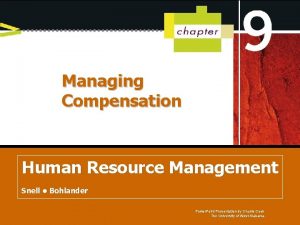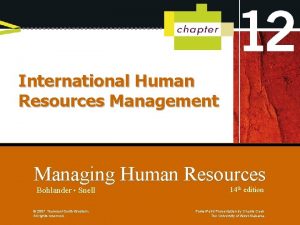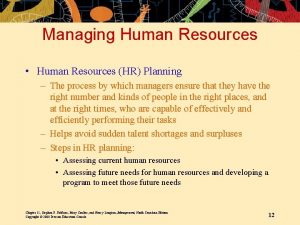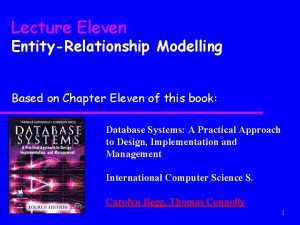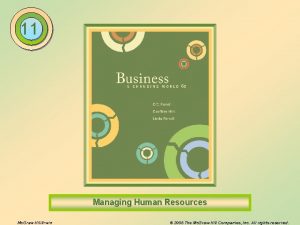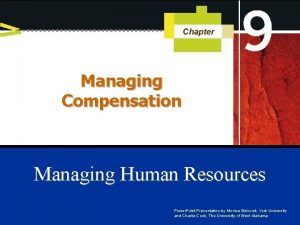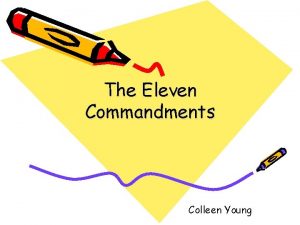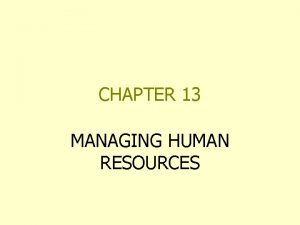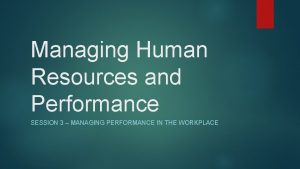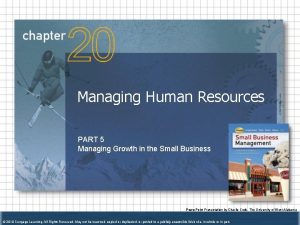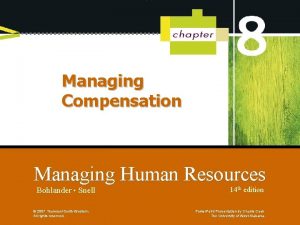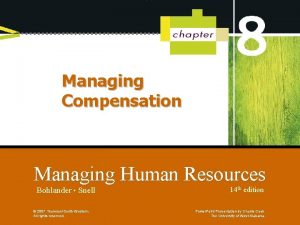Chapter Eleven Managing Human Resources Mc GrawHillIrwin 2003

































- Slides: 33

Chapter Eleven Managing Human Resources Mc. Graw-Hill/Irwin © 2003 The Mc. Graw-Hill Companies, Inc. , All Rights Reserved.

The Nature of Human Resources Management (HRM) • HRM: – All activities involved in determining an organization’s human resource needs, as well as acquiring, training, and compensating people to fill those needs. Mc. Graw-Hill/Irwin © 2003 The Mc. Graw-Hill Companies, Inc. , All Rights Reserved.

Planning for HR Needs • Typical HR Issues: – How many employees? – What skills are needed to satisfy plans? – Availability of people in the workforce? – What qualifications must employees have? – Cost of staffing? Mc. Graw-Hill/Irwin © 2003 The Mc. Graw-Hill Companies, Inc. , All Rights Reserved.

Processes of Job Analysis: The determination through observation and study, of pertinent information about a job, including specific tasks and necessary abilities, knowledge, and skills. Job Description: The formal, written description of a specific job, such as the job title, tasks to be performed, physical and mental skills required, duties, and responsibilities. Job Specification: The written description of the qualifications necessary for a specific job, such as education, experience, personal characteristics, and physical characteristics. Mc. Graw-Hill/Irwin © 2003 The Mc. Graw-Hill Companies, Inc. , All Rights Reserved.

Recruiting New Employees Recruiting Pool Internal Sources Current Employees External Sources “Head Hunters” Universities FAST FACT: Several years ago, 21% of companies said they recruited online. Experts say it over 80% today. Classifieds Source: Bill Leonard, “Online and Overwhelmed, ” HR, vol 45 (August 2000), no 8 from http[: //www. shrm. org/hrmagazine/articles/default. asp? page=0800 cov. htm (accessed May 16, 2001). Mc. Graw-Hill/Irwin © 2003 The Mc. Graw-Hill Companies, Inc. , All Rights Reserved.

The Selection Process App licat ion Inte r view Test ing Mc. Graw-Hill/Irwin Refe r Che ence ckin g Job? © 2003 The Mc. Graw-Hill Companies, Inc. , All Rights Reserved.

Legal Issues in Recruiting and Selecting New Employees • Fair Labor Standards Act (1938). Sets minimum wages and overtime rates (for any time over 40 hours per week). • Equal Pay Act (1963). Requires that men and women who do equal work be paid equally. • Title VII of the Civil rights Act (1964). Created the Equal Employment Opportunity Commission and mandates affirmative action programs. Outlaws employment practices that discriminate on the basis of sex, race, color, or national origin. Mc. Graw-Hill/Irwin © 2003 The Mc. Graw-Hill Companies, Inc. , All Rights Reserved.

Legislation Regulating Hiring and Compensation Practices • Age Discrimination in Employment Act (1967). Outlaws employment practices that discriminate on the basis of age, particularly mandatory retirement before age 70. • Americans with Disabilities Act. Prevents discrimination against disabled persons. Classifies AIDS as a handicap and prohibits using a positive AIDS test as reason to deny employment. FAST FACT: 40+ years after the Civil Rights Act was passed, corporate officers are only 8. 2% African-American, 5% Hispanic, and 12. 5% women. Source: Annie Finnigan, “Different Strokes, ” Working Woman, April 2001, p. 42. Mc. Graw-Hill/Irwin © 2003 The Mc. Graw-Hill Companies, Inc. , All Rights Reserved.

Affirmative Action Legally mandated plans that try to increase job opportunities for minority groups by analyzing the current pool of workers, identifying areas where women and minorities are underrepresented, and establishing specific hiring and promotion goals, with target dates, for addressing discrepancy. Mc. Graw-Hill/Irwin © 2003 The Mc. Graw-Hill Companies, Inc. , All Rights Reserved.

Steps in Developing the Workforce 1. Employee Orientation 2. Employee Training & Development 3. Assessing Employee Performance FAST FACT: Internet-based training is expected to grow to be a $14. 5 billion market by 2004. Source: Karen Morrione, “Live and E-Learn, ” Working Woman, April 2001, p. 34. Mc. Graw-Hill/Irwin © 2003 The Mc. Graw-Hill Companies, Inc. , All Rights Reserved.

Employee Turnover • Promotion • Transfer • Separation – – Mc. Graw-Hill/Irwin Resignation Retirement Termination Layoffs © 2003 The Mc. Graw-Hill Companies, Inc. , All Rights Reserved.

Compensating the Work Force Time Wages Piece Wages Commission Mc. Graw-Hill/Irwin Financial award based on number of hours worked Financial award based on the output attained by the employee Payment to an employee of a fixed amount or a percentage of the employee’s sales © 2003 The Mc. Graw-Hill Companies, Inc. , All Rights Reserved.

Compensating the Workforce Salary Bonus Profit sharing Mc. Graw-Hill/Irwin Financial award calculated on a weekly, monthly, or annual basis An addition to regular compensation for exceptional performance or in appreciation for good work Distribution of percentage of company profit to employees; sometimes distribution is in the form of company stock © 2003 The Mc. Graw-Hill Companies, Inc. , All Rights Reserved.

Other Methods Companies Use to Retain Employees 66% Tuition Reimbursement Better Pay and Benefits 60% Flexible Hours & Schedules 53% Mentoring Programs 25% 22% Profit-Sharing Exercise Facilities 15% Source: Kemba J. Dunham, The Jungle, ” Wall Street Journal, May 15, 2001, p. B 12. Mc. Graw-Hill/Irwin © 2003 The Mc. Graw-Hill Companies, Inc. , All Rights Reserved.

Increasing Employee Satisfaction American Workers Prefer Happiness Over Money What American’s Value Most About Work: Job Satisfaction: 65% Being Paid Well: 34% Having an Important Title: 1% Source: USA Today Snapshots, September 20, 2001, D-1. Mc. Graw-Hill/Irwin © 2003 The Mc. Graw-Hill Companies, Inc. , All Rights Reserved.

Increasing Employee Satisfaction Benefits: 1. Child care assistance 2. Elder care programs 3. Flexible schedules 4. Adoption benefits 5. Personal/professional growth 6. Financial security programs 7. Group/discounted purchases 8. On-site personal services 9. Casual dress % Offering 91 49 73 32 78 41 39 57 66 Source: “Hewitt Study Shows Work/Life Benefits Continue to Grow Despite Slowing Economy, ” Hewitt Associates LLC press release, April 23, 2001. Mc. Graw-Hill/Irwin © 2003 The Mc. Graw-Hill Companies, Inc. , All Rights Reserved.

Managing Unionized Labor • Labor Unions: – Employee organizations formed to deal with employers to achieve better pay, hours, and working conditions. Mc. Graw-Hill/Irwin © 2003 The Mc. Graw-Hill Companies, Inc. , All Rights Reserved.

Managing Unionized Labor Collective Bargaining: – The negotiation process through which management and unions reach agreement about compensation, working hours, and working conditions for a bargaining unit. Mc. Graw-Hill/Irwin Labor Contract: – The formal, written document that spells out the relationship between the union and management for a specified period of time – usually two or three years. © 2003 The Mc. Graw-Hill Companies, Inc. , All Rights Reserved.

The Collective Bargaining Process Management prepares list of demands and concessions: Scheduling Hiring and firing Pay cuts Production standards Discipline Union prepares list of demands and concessions: Pay raises Overtime rates Benefits Security Seniority Negotiation teams establish rules and schedule meetings Negotiation and compromise Ratification of contract Union represents workers at that work facility Rejection of contract Union tactics: Strikes, Boycotts, Picketing Management tactics: Lockouts, Strikebreakers Renegotiation of contract Mc. Graw-Hill/Irwin © 2003 The Mc. Graw-Hill Companies, Inc. , All Rights Reserved.

Resolving Disputes: Pressure Tactics of Labor and Management Labor’s Tactics • Strikes • Picketing • Boycott Management’s Tactics • Lockout • Strikebreakers/hiring replacements Mc. Graw-Hill/Irwin © 2003 The Mc. Graw-Hill Companies, Inc. , All Rights Reserved.

Dispute Resolution • Conciliation • Mediation • Arbitration Mc. Graw-Hill/Irwin © 2003 The Mc. Graw-Hill Companies, Inc. , All Rights Reserved.

Diversity in the Workplace • Diversity: – The participation of different genders, races, ethnicities, nationalities, and abilities in the workplace. Mc. Graw-Hill/Irwin © 2003 The Mc. Graw-Hill Companies, Inc. , All Rights Reserved.

Characteristics of Diversity Secondary Characteristics • Education • Work Background • Income • Marital Status • Parental Status • Military Experience • Religious Beliefs • Geographic Location Mc. Graw-Hill/Irwin Primary Characteristics Sexual Orientation Age Gender Race Ethnicity Abilities © 2003 The Mc. Graw-Hill Companies, Inc. , All Rights Reserved.

Characteristics of Diversity 2000 Population 281, 421, 906 White Persons African-American Persons American Indian/Alaskan Persons Asian Persons Native Hawaiian/Pacific Islander Hispanic/Latino Persons 75. 1% 12. 3% 0. 9% 3. 6% 0. 1% 12. 5% Source: “USA Quick. Facts from the US Census Bureau” from http: //quickfacts. census. gov/qfd/states/00000. html (accessed June 8, 2001). Mc. Graw-Hill/Irwin © 2003 The Mc. Graw-Hill Companies, Inc. , All Rights Reserved.

The Benefits of Workforce Diversity 1. 2. 3. 4. 5. 6. More productive use of a company’s human resources. Reduced conflict among employees of different backgrounds as they learn to respect each other’s differences. More productive working relationships. Increased commitment to and sharing of organizational goals among diverse employees at all organizational levels. Increased innovation and creativity. Increased ability to serve the needs of an increasingly diverse customer base. Mc. Graw-Hill/Irwin © 2003 The Mc. Graw-Hill Companies, Inc. , All Rights Reserved.

HRM Pays • The median annual income for various HR jobs: – – – Mc. Graw-Hill/Irwin Benefits Director Training Director HR Director Training Material Development Specialist Recruitment & Interviewing Specialist $105, 865 84, 516 78, 968 58, 403 51, 669 © 2003 The Mc. Graw-Hill Companies, Inc. , All Rights Reserved.

Solve the Dilemma 1. What did Medallion’s HRM department do right in dealing with the employees who were laid off? 2. What are some of the potential problems that must be dealt with after an organization experiences a major trauma such as massive layoffs? 3. What can Medallion do to make the team approach work more smoothly? What role do you think diversity training should play? Mc. Graw-Hill/Irwin © 2003 The Mc. Graw-Hill Companies, Inc. , All Rights Reserved.

Explore Your Career Options What are some of the factors you consider most important in deciding which job to accept after graduation? Is your decision about your college major most influenced by salary, hiring potential in particular areas, or quality of life issues? Mc. Graw-Hill/Irwin © 2003 The Mc. Graw-Hill Companies, Inc. , All Rights Reserved.

Additional Discussion Questions and Exercises 1. applicants? Where do most firms recruit qualified 2. Why has the use of physical examinations in the selection process become controversial for business? 3. add to Employee Assistance Programs (EAPs) company costs. Why should a firm bother with EAPs ? 4. Bring a copy of a local newspaper “Help Wanted” section to class. What qualifications (job specifications) do the ads Mc. Graw-Hill/Irwin © 2003 The Mc. Graw-Hill Companies, Inc. , All Rights Reserved.

Additional Discussion Questions and Exercises 5. Bring a copy of a performance appraisal form to class. Copies may be secured from companies or examples may be presented in textbooks. Is the performance appraisal based on objective or subjective information? Is the performance appraisal based on preset objectives for the individual employee? Mc. Graw-Hill/Irwin © 2003 The Mc. Graw-Hill Companies, Inc. , All Rights Reserved.

Chapter 11 Quiz 1. Which of the following positions is most likely to be compensated through commissions? a. counter worker at a fast-food restaurant b. bricklayer c. automobile salesperson d. secretary 2. Which of the following is not an example of a benefit? a. bonuses b. retirement plans c. health insurance d. credit union membership Mc. Graw-Hill/Irwin © 2003 The Mc. Graw-Hill Companies, Inc. , All Rights Reserved.

Chapter 11 Quiz 3. settle is 4. Which of the following brings in a neutral third party to the dispute in which the decision made by the third party legally binding and enforceable? a. boycott b. conciliation c. mediation d. arbitration Which of the following is NOT a benefit of work-force diversity? a. more productive use of company's human resources b. reduced conflict among employees of different ethnicities c. increased conflict among employees of different ethnicities increased innovation and creativity Mc. Graw-Hill/Irwin d. © 2003 The Mc. Graw-Hill Companies, Inc. , All Rights Reserved.

Multiple Choice Questions about the Video 1. health Why are some organizations providing on-site gyms or discounted memberships to outside health clubs? a. to improve employee health b. to reduce health care costs to the organization c. to reduce the number of work days lost due to problems d. all of the above 2. Which of the following is the most likely reason that firms are offering innovative programs that target employees’ physical and emotional well-being? a. to reduce turnover b. because they just want to be nice c. to give in to employee demands d. because the union made them do it Mc. Graw-Hill/Irwin © 2003 The Mc. Graw-Hill Companies, Inc. , All Rights Reserved.
 Chapter 10 managing human resources
Chapter 10 managing human resources Managing human resources in small and entrepreneurial firms
Managing human resources in small and entrepreneurial firms Employee selection
Employee selection Managing global human resources
Managing global human resources Managing human resources bohlander
Managing human resources bohlander Managing human resources bohlander
Managing human resources bohlander Managing human resources in small and entrepreneurial firms
Managing human resources in small and entrepreneurial firms Managing hospitality human resources
Managing hospitality human resources Managing global human resources
Managing global human resources Managing data resources
Managing data resources Resources application
Resources application Important
Important Data resources in information system
Data resources in information system Information technology resource
Information technology resource Chapter 9 human resources management
Chapter 9 human resources management Chapter 8 study guide human resources culture and diversity
Chapter 8 study guide human resources culture and diversity Chapter 8 human resources culture and diversity
Chapter 8 human resources culture and diversity Chapter 5 human resource planning and recruitment
Chapter 5 human resource planning and recruitment Chapter 27 human impact on earth resources
Chapter 27 human impact on earth resources Intro to human resource management
Intro to human resource management Chapter 9 human resources management
Chapter 9 human resources management The transformation process in operations management
The transformation process in operations management Fixed resources
Fixed resources Renewable vs nonrenewable resources worksheet
Renewable vs nonrenewable resources worksheet Chapter 8 human needs and human development
Chapter 8 human needs and human development Chapter 8 human needs and human development
Chapter 8 human needs and human development Wmata human resources
Wmata human resources Human resources acronyms
Human resources acronyms Uf hr benefits
Uf hr benefits Characteristics of ihrm
Characteristics of ihrm Resource histogram vs responsibility assignment matrix
Resource histogram vs responsibility assignment matrix What are physical resources
What are physical resources What is job enrichment
What is job enrichment Human resource management in restaurants
Human resource management in restaurants
